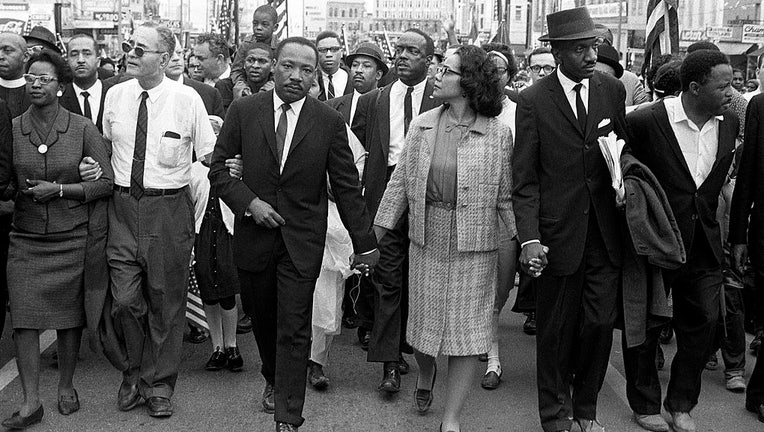House where MLK planned 1965 Selma to Montgomery marches moving to Michigan

Dr. Martin Luther King, Jr. arrives in Montgomery, Alabama on March 25th 1965 at the culmination of the Selma to Montgomery March. (Morton Broffman/Getty Images)
DEARBORN, Mich. - A lot was happening in March 1965 in the bungalow in Selma, Alabama, that then-4-year-old Jawana Jackson called home, and much of it involved her "Uncle Martin."
There were late-night visitors, phone calls and meetings at the house that was a safe haven for the Rev. Martin Luther King Jr. and other civil rights leaders as they planned the Selma to Montgomery marches calling for Black voting rights.
The role the Jackson House played was integral to the Civil Rights Movement, so Jackson contacted The Henry Ford Museum near Detroit about a year ago to ask if it would take over the preservation of the Jackson House and its legacy.
RELATED: The Embrace statue unveiled in Boston on MLK weekend
"It became increasingly clearer to me that the house belonged to the world, and quite frankly, The Henry Ford was the place that I always felt in my heart that it needed to be," she told The Associated Press last week from her home in Pensacola, Florida.
Starting this year, the Jackson House will be dismantled piece-by-piece and trucked the more than 800 miles (1,280 kilometers) north to Dearborn, Michigan, where it will eventually be open to the public as part of the history museum. The project is expected to take up to three years.
Owned by dentist Sullivan Jackson and his wife, Richie Jean, the 3,000-square-foot (28-square-meter) home was where King and others strategized the three marches against racist Jim Crow laws that prevented Black people from voting in the Deep South.
RELATED: Americans should 'pay attention' to MLK's legacy, Biden says in Ebenezer sermon
King was inside the home when President Lyndon Johnson announced a bill that would become the Voting Rights Act of 1965.
"There was a synergy going on in that house during those critical times," Jawana Jackson said. "Whether that was when Uncle Martin was praying the morning of the Selma to Montgomery march or whether he was talking to President Johnson (by phone) in the little bedroom of that home, I always got a sense of energy and a sense of hope for the future."
The house and artifacts, including King's neckties and pajamas, and the chair where he sat while watching Johnson's televised announcement, will be part of the acquisition by The Henry Ford. The purchase price is confidential.
Named after Ford Motor Co. founder and American industrialist Henry Ford, the museum sits on 250 acres (100 hectares) and also features Greenfield Village where more than 80 historic structures are displayed and maintained.
The Jackson House will be rebuilt there, joining the courthouse where Abraham Lincoln first practiced law, the laboratory where Thomas Edison perfected the light bulb, and the home and workshop where Orville and Wilbur Wright invented their first airplane.
Also, among the collection's artifacts are the Montgomery city bus whose seat Rosa Parks refused to give up to a white man in 1955 and the chair that Lincoln was sitting on in 1865 when he was assassinated at Ford's Theatre in Washington.
Visitors to Greenfield Village will be able to walk through the Jackson House, according to Patricia Mooradian, The Henry Ford’s president and chief executive.
"This house is the envelope, but the real importance is what happened inside," Mooradian said. "We want people to immerse themselves in that history ... to feel and experience what may have gone on in that home. What were the conversations? What were the decisions that were being made around the dining room table?"
Built in 1912, the home served as a guest house for Black authors W.E.B. Dubois and Booker T. Washington who held "fireside chats" regarding education, religion, the arts, community building and economic sustainability, according to the Alabama African American Civil Rights Heritage Sites Consortium.
It took on a greater importance following the fatal shooting of a young Black man, Jimmie Lee Jackson, by an Alabama trooper.
On March 7, 1965, weeks after that slaying, about 600 people participated in a peaceful protest. The late Georgia U.S. Rep. John Lewis was one of the leaders of the planned 54-mile (86-kilometer) march to the state Capitol, which was part of the larger effort to register Black voters. But police beat protesters as they tried to cross the Edmund Pettus Bridge in Selma in what is now known as "Bloody Sunday."
Television and newspaper reports seared images of that confrontation into the nation's consciousness. Days later, King led what became known as the "Turnaround Tuesday" march, in which marchers approached police at the bridge and prayed before turning back.
Johnson introduced the Voting Rights Act of 1965 eight days after "Bloody Sunday." On March 21, King began a third march, under federal protection, that grew to thousands of people by the time it arrived at the state Capitol. Five months later, Johnson signed the bill into law.
The Jackson House brings a new dimension to understanding the role Black Americans played in defeating Jim Crow, according to historian Gretchen Sullivan Sorin.
"The Jacksons are unsung heroes," Sorin said. "Their generosity and courage shows us how we, as ordinary Americans, can stand up against injustice."
Jackson said her parents felt the risks were worth taking.
"For them, it was all about the future for me and millions of other children that were going to grow up," she said. "They felt that everyone deserved a peaceful and more democratic society to grow up in."
Williams is a member of AP's Race & Ethnicity team.

